
Maritime tour is trove of culture, history
SAN FRANCISCO — Notoriously commercialized and brimming with map wielding tourists, Fisherman’s Wharf seems like a JC Penny in the sea of mom and pop boutiques that are the rest of the neighborhoods in San Francisco.
But, just across the street from the Rainforest Café, In and Out Burger and souvenir-hawking vendors lie several historically and culturally rich locations along the Historic Waterfront Walking Tour at the San Francisco Maritime.
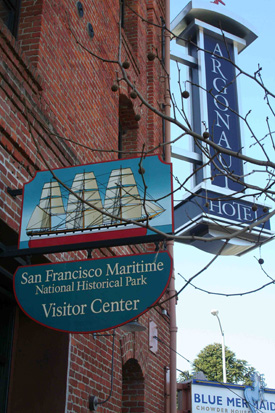 |
At left, the entrance of the Argonaut Hotel and the Visitor Center of the San Francisco Maritime National Historical Park. Below, from top, the old Del Monte cannery, the Fishermen’s and Seamen’s Memorial Chapel at Pier 45, fishing boats in San Francisco harbor, tourist Lacie Babb takes a photograph of fishing boats during the Historic Waterfront Walking Tour, and a ranger leads the tour (Photos by Meaghan Fondillier). |
Led by Interpretive Park Ranger Tom Jares, the one hour tour, offered Saturdays and Sundays at 10:30 a.m., makes eight different stops along San Francisco’s northern waterfront beginning in the lobby of the century-old Argonaut Hotel.
“We’re here because it’s a free and simple way to get a little more information about what’s gone on in the past 100 years,” said Johnny Vasquez, a visitor to San Francisco, who was on the tour.
Vasquez, on the tour with his girlfriend, Lacie Baab, and her grandparents, Joan and David Baab, was also there partly because of his competitive nature. The native of Long Beach, Calif. was determined to become a key player in the Baab family’s long-standing challenge to see who can get the most National Park Service site stamps throughout their lifetime.
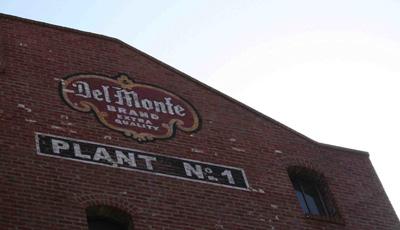 “I’m definitely winning,” said Joan who had just visited parks all the way from Washington State to Phoenix with her husband in March. She and David see their retirement as the perfect opportunity to gain an advantage in the friendly race with their family members.
“I’m definitely winning,” said Joan who had just visited parks all the way from Washington State to Phoenix with her husband in March. She and David see their retirement as the perfect opportunity to gain an advantage in the friendly race with their family members.
After a brief history of the Argonaut Hotel, which was formerly the Del Monte cannery, the West Coast’s largest producer of fruits and vegetables in 1916, Jares led the group into the courtyard that served as the loading dock for the warehouse.
Now serving tourists, the open-air space offers several restaurants including Norman’s Ice Cream and Jack’s Bar, which boasts more than 68 beers on tap.
The ranger then guides the group (typically numbering anywhere from two and 20 visitors) around the corner to the world-famous cable car turn-around at the intersection of Hyde and Beach streets.
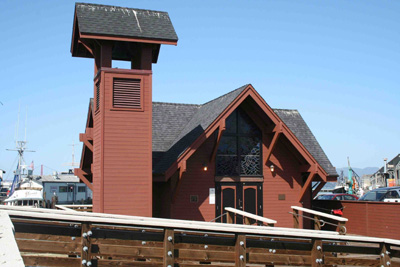 “This is the real thing,” said Jares. “The very first and last remaining in the country.”
“This is the real thing,” said Jares. “The very first and last remaining in the country.”
The turn-around is just yards from the shore of the San Francisco Bay and the cable cars are bright against the calm water and clear blue sky – a novelty in the infamously foggy city. A line of people snakes around, folding on top of itself waiting for a chance to hang from the car as it chugs up and down San Francisco’s steepest hills.
The tour then makes a stop in Victorian Park for a brief history of the Ghiradelli Chocolate Factory, which overlooks the park from atop a nearby hill.
The factory opened in 1893 and became Ghiradelli Square in 1970 now functioning as condominiums, restaurants, wine shops and outdoor public space for socializing.
The tour makes its way toward the shore and Aquatic Park, which is home to the Dolphin and South End Rowing Clubs. The group slows at this point in the tour, one visitor trips on the heels of another as they gaze in amazement at the water.
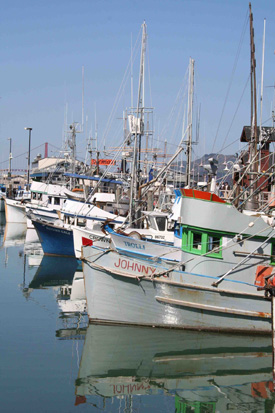 It’s not Alcatraz or even the Golden Gate Bridge that they are marveling at, but rather the group of swimmers taking the plunge into the 49-degree bay water.
It’s not Alcatraz or even the Golden Gate Bridge that they are marveling at, but rather the group of swimmers taking the plunge into the 49-degree bay water.
Although there are no dangerous species of sharks in this brackish water, the temperature seems threatening enough to deter this group of tourists from diving in themselves.
Once the group had run out of “oooh’s,” “aaahs” and “oh my God’s”, Jares sets out toward the climax of the tour, the Hyde Street Pier. Before the opening of the Golden Gate Bridge in 1948 it was a bustling ferry pier, providing commuters with access to Sausalito. The Hyde Street Pier lay dormant for 12 years until the state park service took it over and rehabilitated it in 1960.
Now the historical tourist attraction feels a bit like stepping back in time, with its antique looking store-fronts and displays which give kids and adults a chance to try their hand at some of the tasks required of them aboard a big ship.
“I don’t really like boats, but he still has me interested in the history,” said Vasquez of Ranger Jares. The park service and its rangers run tours of the pier and the 19th century ships, including the Balcutha, offering a free day once a month.
As the tour meanders back towards the commercialized section of the wharf, it appears that it may be drawing to a close, but Jares has one more location to show. Just out of range of the cameras clicking on the main drag of Fisherman’s Wharf and behind the fleet of modern fishing vessels at Pier 45 is the Fishermen’s and Seamen’s Memorial Chapel, dedicated to all those who have lost their lives at sea.
“It’s the single most dangerous job in the whole country,” said Jares. “It has more fatalities than any other profession.”
According to Jares, visitors come looking for this hidden reddish-brown building to see the bronze plaques engraved with all the names of the deceased.
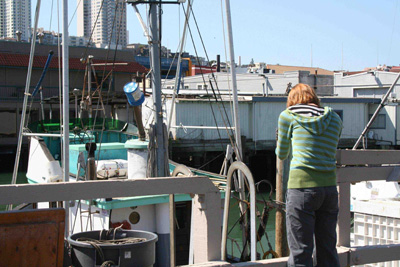 From the pier alongside the chapel, the view is striking. The Golden Gate Bridge is a spire of red, rising tall behind the tiny burgundy chapel and the blue bay spanning the distance in between. A few of the tour goers snap photographs of salty fisherman cleaning out their boats and of Alcatraz, which from this angle sits directly under the bridge.
From the pier alongside the chapel, the view is striking. The Golden Gate Bridge is a spire of red, rising tall behind the tiny burgundy chapel and the blue bay spanning the distance in between. A few of the tour goers snap photographs of salty fisherman cleaning out their boats and of Alcatraz, which from this angle sits directly under the bridge.
Others stroll the length of the pier or, as David did, engage Jares and Ranger Brenden Wilson, who audited the tour, in side conversation.
“I was really fascinated by the cable cars and wanted to know more,” said David Baab.
The avid park attendee walks with a cane, but did not miss a step throughout the mile log tour.
“If I had done it twice it might have become a problem,” said David.
Though he may have been tired his wife, Joan, was already looking forward to getting her next couple of stamps from the Presidio and Alcatraz, other notable national historic sites in San Francisco.
“This was a fabulous tour,” said Joan. “I’ve been to a lot of parks and I’ve always met very dedicated rangers. They really know what they’re talking about and want you to know too.”
If You Go
- The San Francisco Maritime is located on Beach and Polk Streets in the Fisherman’s Wharf area of San Francisco.
-
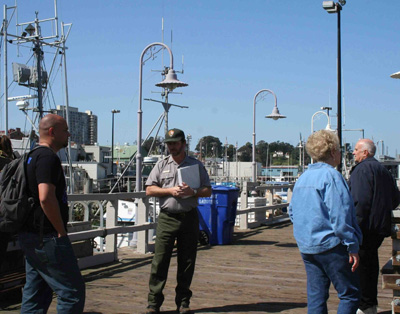 While the museum remains under construction the tour begins in the lobby of the Argonaut Hotel located at the corner of Hyde and Beach Streets (across the street from the Hyde Street Pier).
While the museum remains under construction the tour begins in the lobby of the Argonaut Hotel located at the corner of Hyde and Beach Streets (across the street from the Hyde Street Pier). - The tour is free of cost.
- Parking is by meter or various parking lots (prices range from $10 to $20 for the day)
- Wear comfortable walking shoes and dress according to the weather (layers are always recommended in San Francisco as the temperature fluctuates often).
- For more information about the San Francisco Maritime National Historic Park visit www.nps.gov/sfr/index.htm and for information specific to the Historic Waterfront Walking Tour visit www.nps.gov/sfr/planyourvisit/event.htm and drag your mouse over the calendar to look at this tour and others.

Comments are Closed